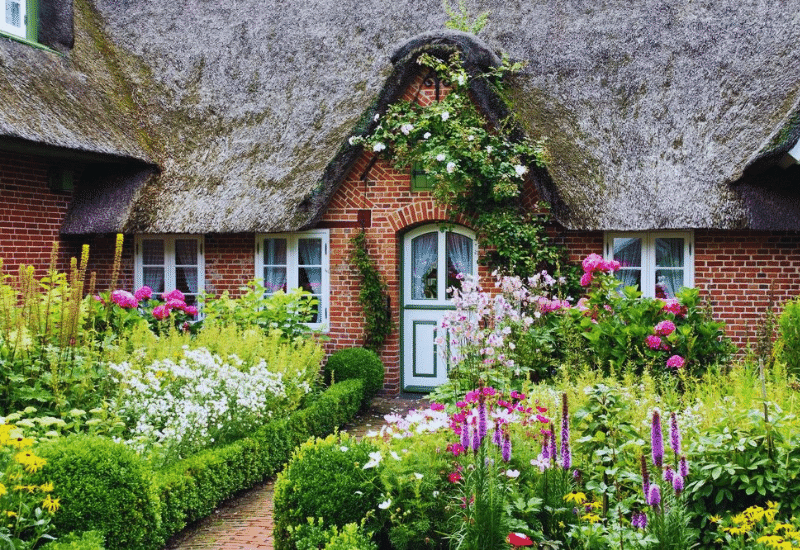
With an abundant mix of informally planted of flowers, foliage and climbers overflowing from beds and borders, a cottage garden is utterly charming haphazard aesthetic at its best.
In fact, if you want a natural and romantic looking garden and you have no patience with “selecting the right plant”, your best choice is a cottage garden.
Invented in the early 18th century, traditional English cottage gardens were grew out of a necessity for self-sufficiency which would include a delightful mix of of vegetables, fruit trees, flowers, and medical herbs alongside livestock enclosed, with a rose-bowered gateway.
But it’s vibrant colored, self-sowing annuals and freely spreading perennials became more of a dominant force in today’s modern cottage gardens.
While it’s not hard to create your own informal flower garden, though to bring that “old world” look of traditional English Gardens you need to choose various colors, sizes, and shapes of plants that “look local and native” (even if they are not) and well adapted to your hardiness zone and growing conditions.
But there are some traditional cottage garden plants, like shrub roses, peonies, lupins, delphiniums, lavender, poppy, iris, honeysuckle and foxglove that you really cannot leave out to achieve a English cottage-style vibe.
Here are more than a dozen of flowering plants that your cottage garden cannot do without if you want that wild but oddly unique look of the “English country garden”.
And they will come with instructions on how to grow them and how to make the best of them for a perfect “cottage look”.
But even if the overall effect of cottage gardens is “random”, there are actually some hidden rules you need to follow. So we need to look at them first.
How To Create The Most Romantic English Cottage Garden
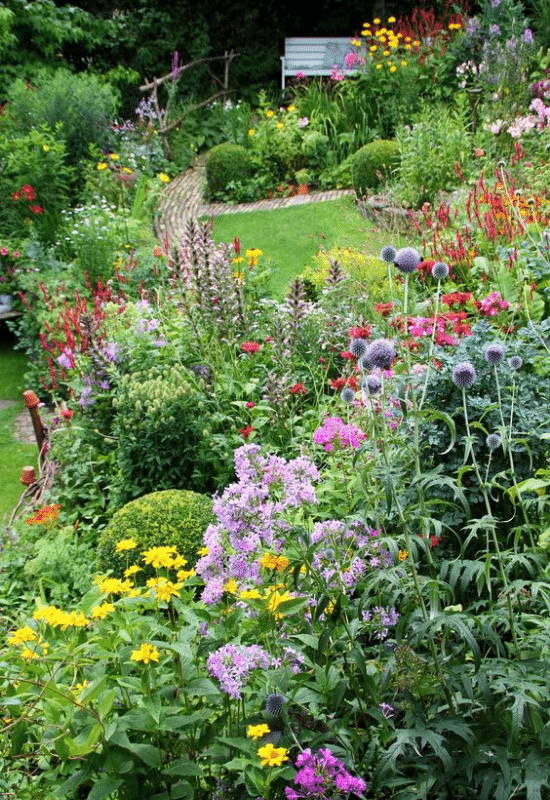
A cottage garden recreates that “old England” look that has some key elements:
But how can you achieve it?
To start with, cottage gardens started to take shape in the times of Shakespeare in England, and they are of rural origin.
In fact the perfect setting is a country cottage reminiscent of that era. But it was only in the late 19th Century that gardner Gertrude Jekyll actually came up with the cottage garden formula we use today. And what is this?
We said that the choice of flowers is huge, really huge for a cottage garden and, as a tip, get a few sachets of “mixed wild prairie flowers” to scatter around in your beds and borders… They will provide excellent backdrop for all the other flowers.
But there are some flowers that scream “cottage garden” and you really need for the perfect look. And here they are…
12 Must Have Flowering Plants for Your English Cottage Garden
From the huge number of flowers you can grow in your cottage garden, here are 14 must-haves cottage garden plants that make perfect choices for a colorful and romantic English-style garden of your dreams
1: Roses (Rosa spp.)
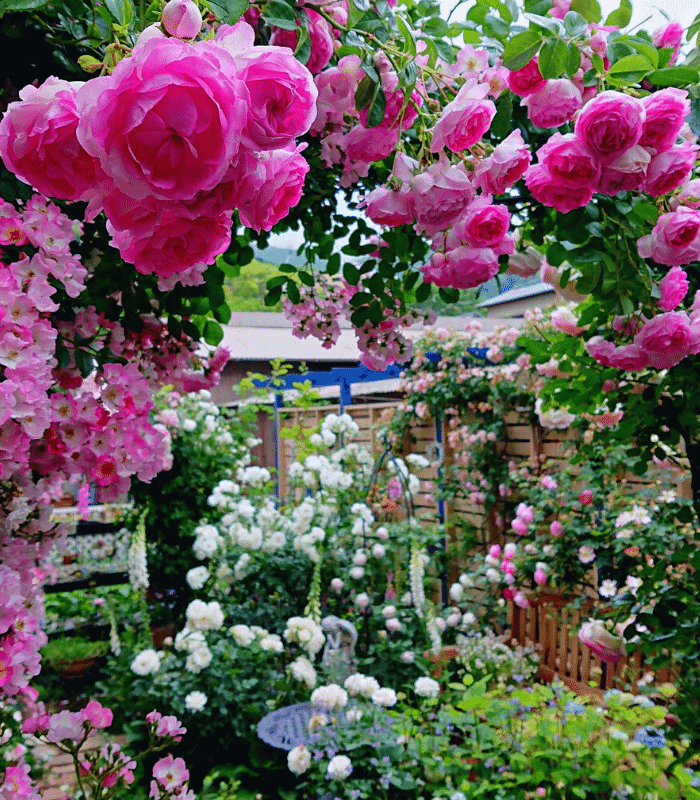
You cannot miss roses in a cottage garden. By all means, roses are typically English and so natural but also romantic looking that no cottage garden can be honestly called so without some rose bushes or climbing roses.
Plant as many as you can, making sure that they have a central role in your garden. But also choose more natural and “old world” looking varieties like ‘America’ or ‘Anne Boleyn’ or ‘Ballerina’ or ‘Bishop’s Castle’.
There are thousands of varieties you can choose from, but mainly look for English roses, climbers, shrub roses and floribunda varieties.
In particular, the flower head is nest if single (a good dog rose or native English rose is perfect), flat, cup and damask rose.
In fact, any old garden rose varieties are fine, but modern roses… You can use them, but maybe not as extensively.
2: Hollyhock (Alcea rosea)
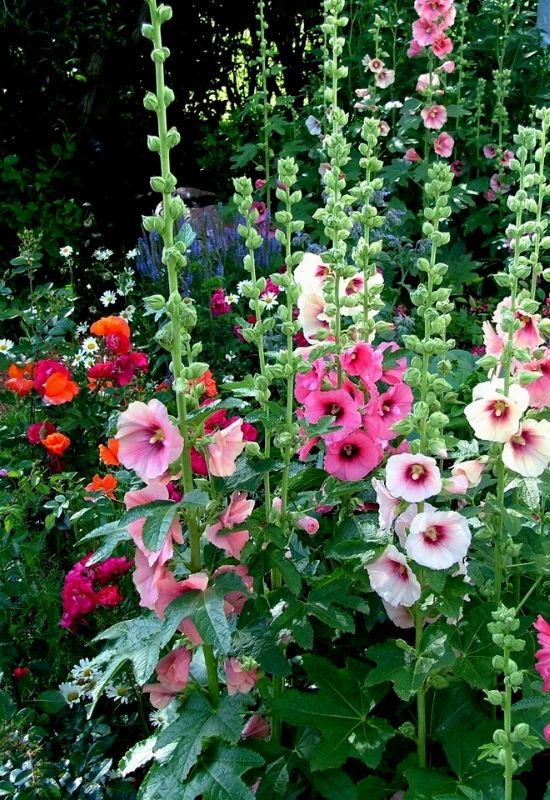
Old-fashioned Hollyhocks (Alcea rosea) are true cottage garden essentials. These dangling giants of flower beds and borders are almost synonymous of traditional English style gardens, in fact.
Often grown as annuals, these drought-resistant short lived perennial is another cottage garden staple have that herbaceous look that such gardens need, long blooming seasons and…
Yes, the key point is that while the flowers are very showy, they look “temperate enough” to look like spontaneous wonder.
In fact the overall look of this close relative of the common mallow is very natural. There is enough variety within the flower shape and leaf shape of each plant to make it look slightly unruly. It is very easy to propagate through seeds, so planting is very easy.
Finally, there is such a wide range of colors (from white to a purple so deep to look like black, via pinks, purples, yellows, oranges and reds) and sizes that you can really go wild with your imagination.
3: Coneflower (Echinacea purpurea)
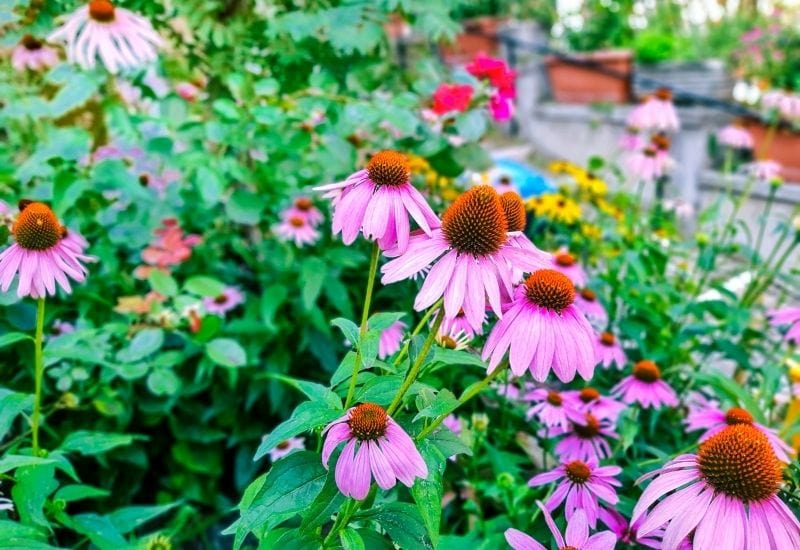
Echinaceas (coneflowers) is a clastic North American perennial favorite among pollinator gardeners and also traditional staples of many English cottage gardens. While this flower is not native of Europe, it had that daisy look that makes it at home all over the world.
Coneflower too is a herbaceous perennial which looks great in clumps and blossoms very profusely.
What is more, its flowers are available in all the warm colors you want, though pink, orange and yellow may well be the most common ones.
It is easy to propagate, it is and looks very strong and sturdy, adaptable to many conditions and – of course – it os a famous medical plant too!
4: Peony (Paeonia spp.)
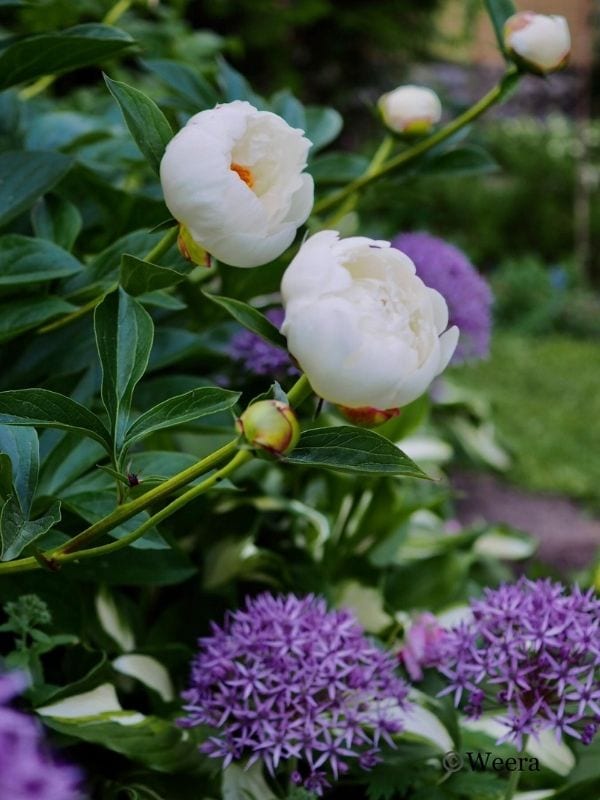
Peonies are another cottage garden favorite since the 17th century. They look perfectly at ease in a very informal environment, in fact, and they form natural clumps.
They are very generous bloomers with those “old world” looking flowers that are just perfect for cottage gardens…
They too have a herbaceous shrub appearance, which, of course, is essential for this type of garden.
They too are very easy to grow, and they come in all sorts of colors (from white to dark purple) and with an excellent range of warm shades.
They also mix very well with other flowers too. There are single and double varieties, and flowers if many sizes.
5: Snapdragon (Antirrhinum spp.)
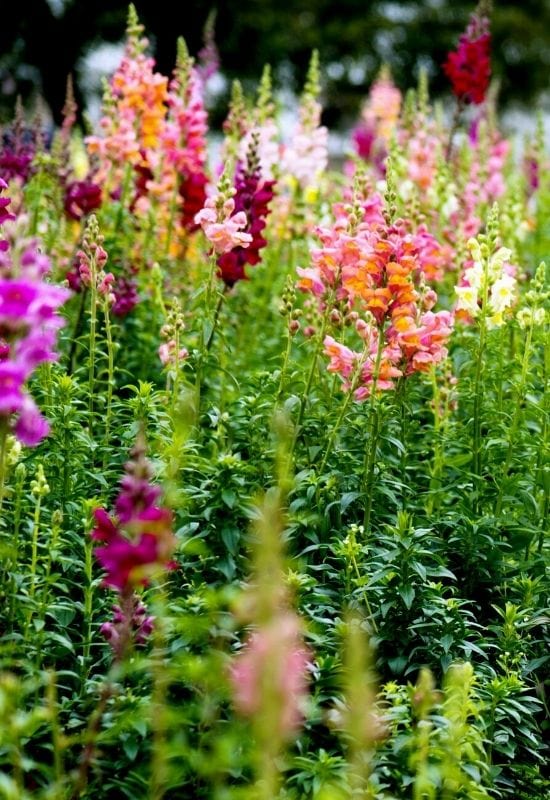
Snapdragon looks like one of those flowers you can find in temperate meadows, on hills and near oak or pine forests. For this reason, it is absolutely perfect for English cottage gardens.
Its spikes filled with brightly colored flowers that look like open mouths… The shape is technically called labiate and it is very endemic of meadows and pastures. And the blooms last – well almost all year!
They are available in a range of colors, from white to violet via pink and magenta. These colors too have a very “temperate” and “wild” connotation.
They look great in clumps and small groups, and because of their spiky shape, they can mix in well with other flowers in borders and beds. They are they types of flowers you would expect in a “posy”, so perfect for the old rural look.
6: Siberian larkspur (Delphinium grandiflorum)
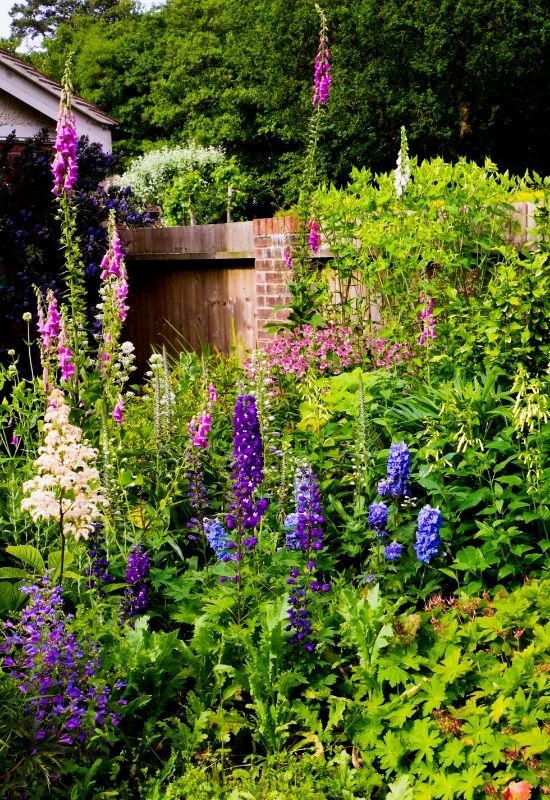
Delphinium also known as Siberian larkspur is another cottage garden classic staple that produces great cut flowers. This sun-loving winter annual Known for its impressive blue range of flowers, that goes from azure to violet, you can also have white and pink ones.
Single and double varieties are available too. Delphinium is easy to grow and its long spikes packed with flowers can bring vibrancy to any garden.
Because you want to mix as many colors as you can in a cottage garden, delphinium can be really useful for the cold range.
It too looks great in clumps and it has that herbaceous look you would expect to find in a wild meadow.
It is a cold hardy perennial which can grow to quite considerable heights in some varieties like the award winning white beauty ‘Jill Curley’.
7: Yarrow (Achillea spp.)
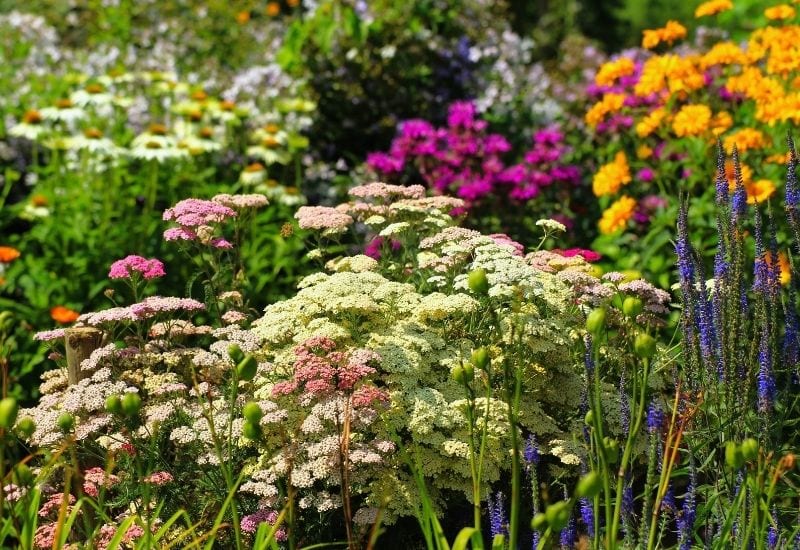
Very few flowers can convey the natural garden look like yarrow. With its large umbels made up of myriad small flowers,
it has that very X factor, or maybe the R factor… the rural factor I mean… In fact it looks like the decorative version of chervil, which is synonymous with temperate wilderness.
You will also need it to bring a different shape to your inflorescences. In fact while spikes are very common in cottage gardens, you need to add some contrasting ones too.
They too are available in many colors, yellow, pink, orange and red, mainly. They are very strong and in some areas, they can even be evergreen. The fern like foliage also provides a wonderful texture for borders and beds.
8: Foxglove (Digitalis purpurea)
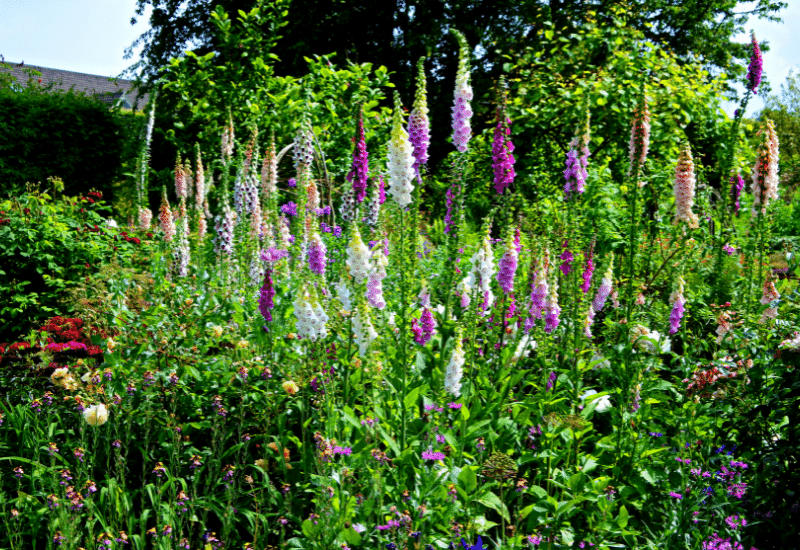
Another spike shaped inflorescence you cannot miss in a cottage garden is foxglove. This biennial has very showy bell shaped flowers that hang from the very long stalk.
They look wonderful in herbaceous borders and flower beds, and they are essential to cottage gardens.
This showy plant can certainly bring any garden to life, but make sure you keep it away from children because it is one of the most poisonous plants we usually grow in gardens…
But its amazing shades of white, pink and magenta bring vibrancy as well as old world romance to your green space like few other plants can do.
9: Columbine (Aquilegia spp.)
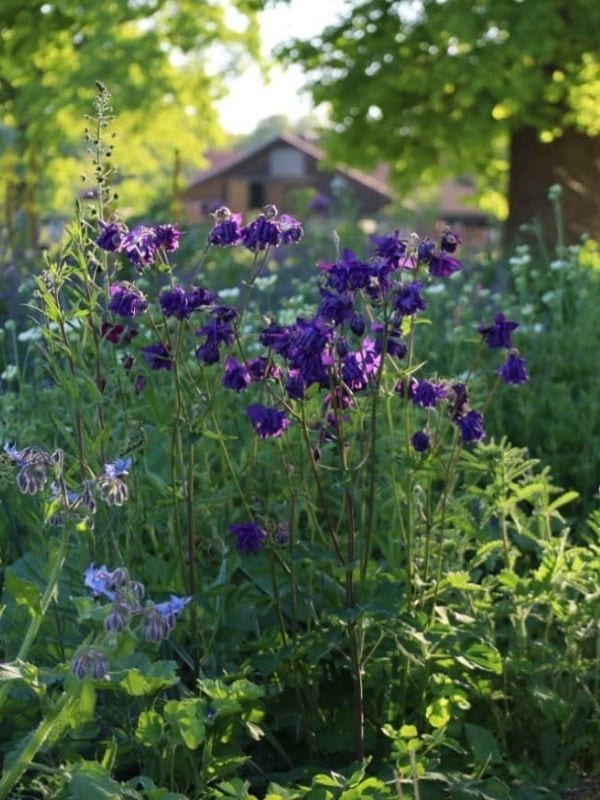
Columbine adds a very original flower shape to the borders and beds of your cottage garden. Its flowers have been described as “jester’s caps” in fact.
But thanks to the herbaceous nature of this plant, the flowers just look perfect in a very informal and natural looking setting. They are favorites of humming birds too, as an extra advantage.
They will need some attention when they are young, but your columbines will become independent and strong when they are mature.
And pf course the wide range of colors you can have these beautiful flowers in is perfect for the wild palette of cottage gardens: white, yellow, orange, pink, red, purple and blue, as well as all combinations of these!
10: Avens (Geum spp.)
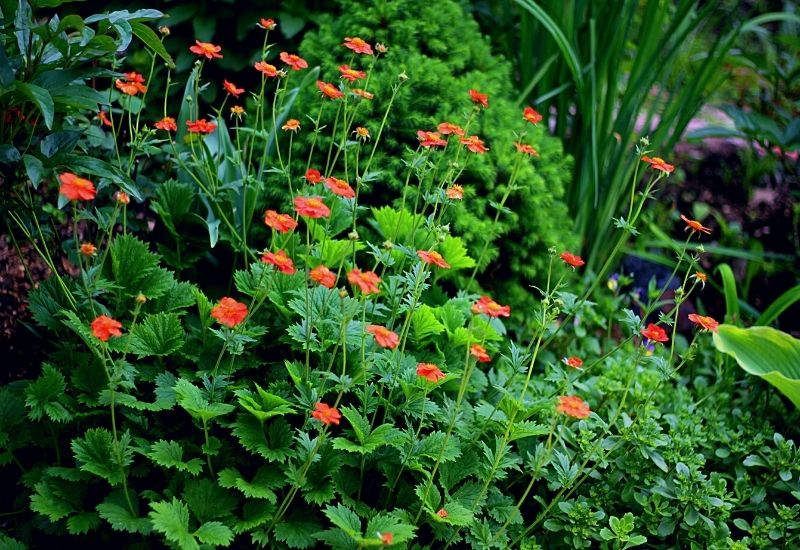
Grown for their profusion of late spring flowers Geum is a great shade-loving plant for a traditional cottage garden looks. Avens flowers appear like butterflies fluttering above the foliage, which gives a great effect in cottage gardens. They are very generous bloomers too, and they are wonderful to add an “outer layer of color” to natural looking borders and beds in your English-style garden.
They are famous for the warmth of their colors, which can be in the yellow to red range, but they are especially loved for their orange tints.
They also bloom for a very long time, starting in late spring. The flowers are sweet and classical looking, with a round and balanced appearance.
The foliage too is very decorative and with a beautiful texture. It is usually green, but there are purple leaved varieties too if you want to add an extra dash of color to your garden.
11: Bee Balm (Monarda spp.)
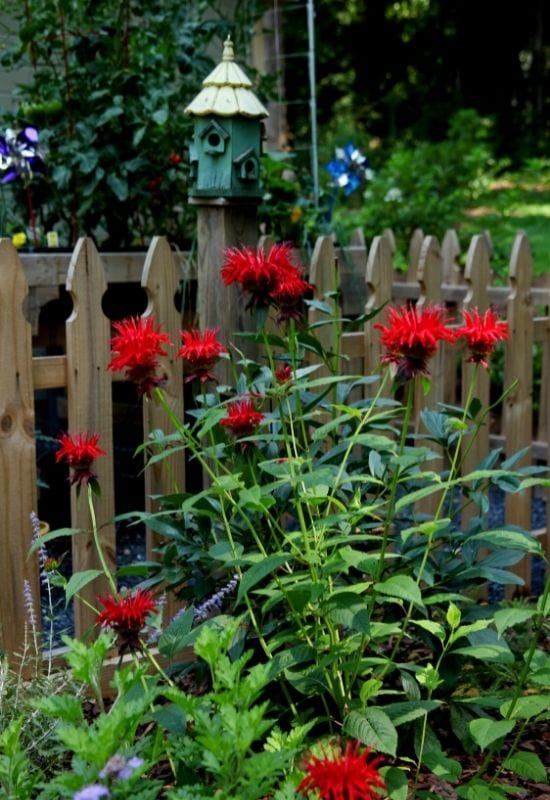
Bee balm is a wild looking herbaceous flowering perennial herb that’s perfect for cottage hardens. It actually looks even rebellious if you get closed to the flowers.
In a way, they come like a crown of “beaks” around a center. They open on long stems that grow taller than the foliage. This too is beautiful; the leaves are broad and pointed, with deep and decorative grooves in them.
The most common colors are purple, magenta, pink and red, but you can find brr balm flowers in blue and white as well.
Bee balm is American native and cottage garden favorite which mix in perfectly well with other herbaceous plants and the shape of their flowers hides a little secret: it is perfect for many pollinators and butterflies.
So, grow bee balm in your cottage garden and you will have many buzzing and colorful flying guests top!
12: Loosestrife (Lysimachia punctata)
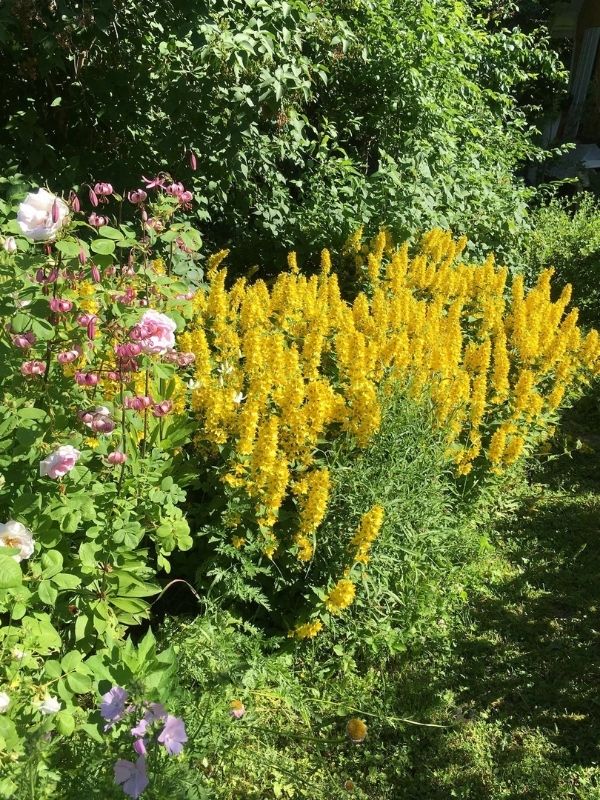
Lysimachia punctata, commonly called yellow loosestrife is low-maintenance vigorous spreading perennial makes a fantastic addition to English-style perennial borders and cottage gardens. This herbaceous perennial forms natural clump with upward pointing stems and star shaped flowers.
These are quite thick, long and covered in beautiful leaves… That makes them perfect fillers for traditional looking cottage garden beds and borders.
But the best comes with the flowers. In fact, those leafy stems transform into amazing spikes of bright yellow star shaped flowers from late spring.
And this plant will keep bringing vibrant energy and light to your cottage garden all through summer. It will look like a wild plant has set foot in your garden and decided to fill it with flowers!
13: Sweet Pea Vines (Lathyrus spp.)
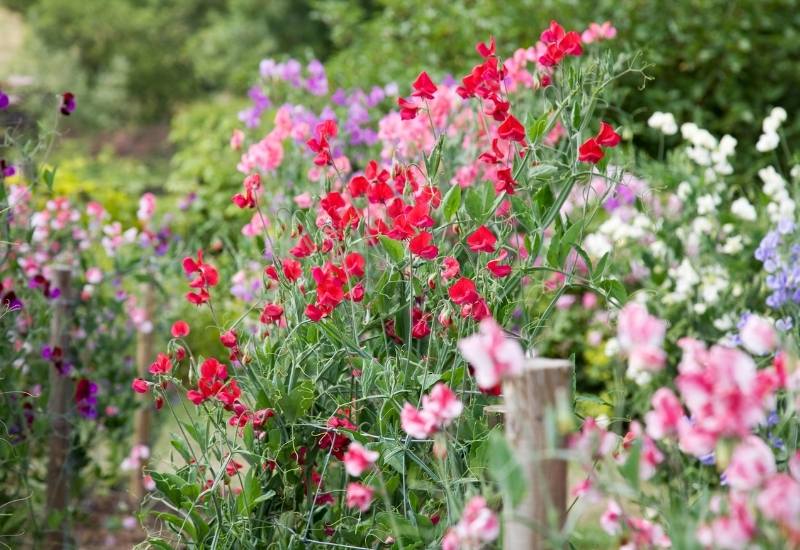
The very success of your cottage garden may depend on sweet peas. This climbing annual or perennial can add height to your blooms, but also an impressive range of colors and blooms that look as vast as oceans.
Fragrant sweet peas are all time favorite rural flowers, actually, they are synonymous with rural life and cottage lie itself…
They are easy to grow hardy annuals that you can get to climb over your gates and on posts or pergolas and fill them with literally all the colors of the rainbow.
There are in fact so many different varieties that you can spend days looking them… And do you know how long the huge blooms will last? From spring all the way to the first frost!
14: Maltese Cross (Lychnis chalcedonica)
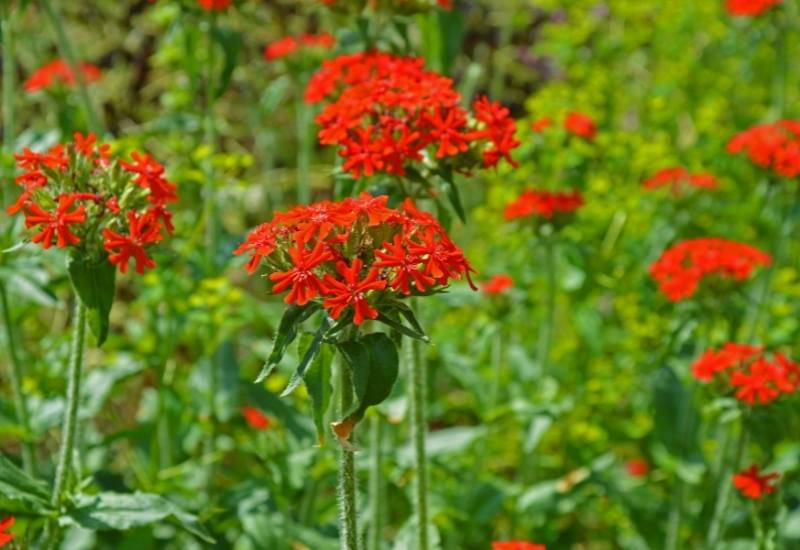
Maltese cross is a wild looking little flowering plant that really adapts to cottage gardens. The flowers are so called because they look like Maltese crosses, of course. Each petal in fact splits in two towards the end.
They have been grown in European gardens for centuries, so they are very traditional flowers indeed, like heritage flowers.
Unfortunately, nowadays they are less popular, as they look great in informal, wild looking and rural gardens, but they may not be your best choice for a formal or urban garden.
The most common variety has scarlet flowers, of the deepest and brightest red you can imagine. And this can have a wonderful effect in a garden (red brings perspective), but tehre are also pink and white ones you can choose.
Twelve Stars in a Milky Way if Flowers
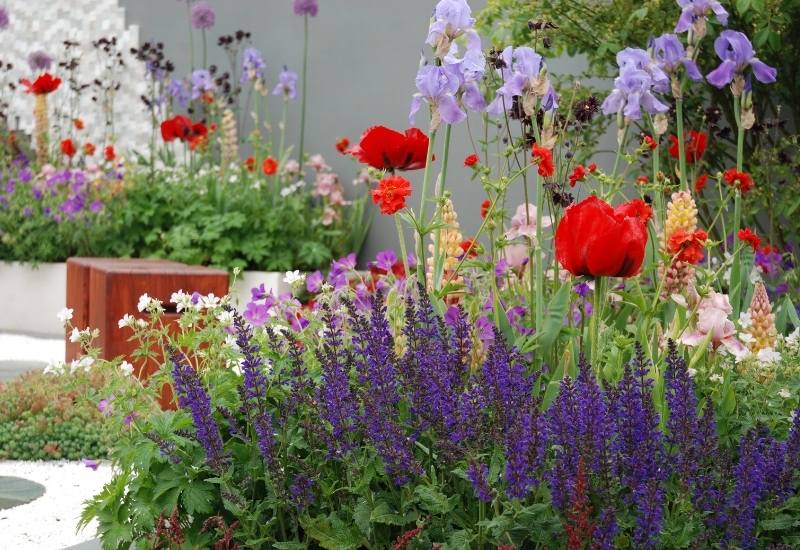
These are the 12 must have flowers for your cottage garden. But now that you know what the key principles are, do pick and choose others too.
No massive exotic flowers, of course, but many natural looking herbaceous flowers are perfect too.
And if these are the “twelve constellations” of your garden, fill it in with many other brightly colored flowers and you will end up with a wonderful milky way in bloom.

Written By
Amber Noyes
Amber Noyes was born and raised in a suburban California town, San Mateo. She holds a master’s degree in horticulture from the University of California as well as a BS in Biology from the University of San Francisco. With experience working on an organic farm, water conservation research, farmers’ markets, and plant nursery, she understands what makes plants thrive and how we can better understand the connection between microclimate and plant health. When she’s not on the land, Amber loves informing people of new ideas/things related to gardening, especially organic gardening, houseplants, and growing plants in a small space.

What beautiful pictures. I just bought a small farm house and wanted to create a cottage garden. You have encouraged me.
Thank you 🌻
Thank you for this inspiring article Amber! Today, we had to cut down the huge maple that has shaded our backyard for decades. As sad as that it, the new light that will be coming in make an English garden an option we have never had before. This article has started us on the path to designing and planting one for the spring. Thank you for helping us to plan and dream about beautiful gardens!
That is exciting! I am wanting to re-do my front bed into an English-Style garden and this really helped. Now to figure out height differences. 🙂